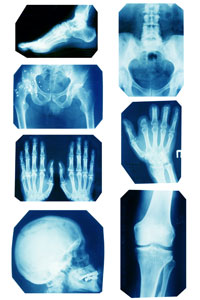![]()
Carpal Tunnel Syndrome
Facts | Symptoms | Prevention | Treatment options
Facts
Carpal tunnel syndrome is not an uncommon condition in today’s world that revolves around all things electronic. Constant, repetitive movement of the hands frequently accounts for this syndrome.
Swelling
of the carpal tunnel tissues due to injury or trauma causes the median nerve at the wrist to compress. This nerve connects and supplies sensation
to many other areas of the hand. This swelling can be a result of constant
typing, driving, assembly-line work, writing or the use of hand tools.
nerve at the wrist to compress. This nerve connects and supplies sensation
to many other areas of the hand. This swelling can be a result of constant
typing, driving, assembly-line work, writing or the use of hand tools.
[top]
Symptoms
- Numbness and tingling in the fingers, especially in the tip of the thumb and along the index and middle fingers
- Weakness in the hand
- Mild or severe pain in the hand
- Difficulty gripping an object
- Tendency to drop objects
- Pain in the joints of the fingers
- Loss of ability to sense temperature
- Sensation that hand is “asleep”
[top]
Prevention
Click here to learn about ways to prevent carpal tunnel syndrome.
[top]
Treatment
If left untreated, carpal tunnel syndrome can cause the nerve to become damaged, which leads to muscle injury and weakness that may be irreversible. If any of the above symptoms are present, it’s best to seek treatment, even if symptoms are mild. This can include simply resting and/or splinting the wrists for a couple of weeks or making other small lifestyle changes to prevent further development of the disease. Persistent symptoms can be treated with medications such as anti-inflammatory drugs or diuretics.
In more serious cases, surgery is ultimately required to relieve pressure from the nerve. A procedure called carpal tunnel release relieves pressure by cutting the ligament covering the median nerve. This surgery usually takes away pain symptoms. Surgery is most successful when performed before permanent damage has occurred.
[top]







